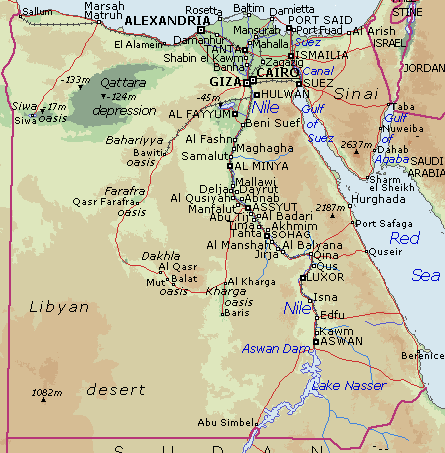Egypt is one of the cradles of civilization in the Middle East. Traces of early man were found in Egypt dating back as early as 700,000 years ago. Egypt and ancient Canaan to the north probably served as the bridges by which successive waves of humans: homo erectus, homo habilis, homo neanderthalensis and homo sapiens, evidently migrated out of Africa and into Mesopotamia and Europe. Ancient Egyptians used a phonetic-pictograph writing called hieroglyphics by the Ancient Greeks. This system evolved from portrayal of pictures of objects to using stylized representation of objects to represent sound combinations and compose words, to a phonetic alphabet much like our own. Ancient Egypt boasted considerable achievements in art, medicine, astronomy and literature, and was the hub of civilization in much of the Near East and North Africa. The unique history of ancient Egypt and visible monuments to that history helped Egyptians preserve a distinct national consciousness, and to remain a separate entity during the years of Arab, Mameluke and Ottoman conquest. |  |
skip to main |
skip to sidebar
99countres
Followers
Popular Posts
-
Timbuktu (Timbuctoo) (Koyra Chiini: Tumbutu; French: Tombouctou) is a city in Tombouctou Region, in the West African nation of Mali. ...
-
Great Wall of China Great Wall of China Great Wall of China Great Wall of China Great Wall of China Great Wall of China
-
Norway is an excellent vacation destination for eco-friendly travelers for this very reason. Its gorgeous landscapes and environmentally f...
-
Kyoto Japan Temple Kyoto Japan Temple Kyoto Japan Temple Kyoto Japan Temple Kyoto is for Japanese the city that most clearly symbolises t...
-
Puerto viejo Beach Puerto viejo Beach Puerto viejo Beach Puerto viejo Beach Puerto viejo Beach
-
Oh, Dubai. Sometimes we wish you success, because you’re so funny. Other times we can’t wait till you run out of oil and just turn...
-
Abu Dhabi (Arabic: أبو ظبي Abū ẓabī , literally Father of gazelle ) is the capital of, and the second largest city in the United Arab ...
Feedjit
Blog Archive
-
▼
2010
(143)
-
▼
May
(29)
- America famouse places
- China in the Springtime
- Search of a Cool Summer: Kunming, China pictures
- South America
- Deyaar tower pictures
- Executive Heights pictures
- Emirates Crown 45th-tallest building in the world.
- Norway pictures
- Diffrent Beautifull Places
- Norway beautiful places
- NORWAY VACATION PLACE
- world highest buildings
- Marina Crown pictures
- Dubai Marina Tower
- dubai adax park buildings pictures
- Grosvenor Square building history
- Usa famous place pictures
- Malaysia style asia
- U.S.A famous place
- Iran pictures
- Egypt country
- Map of Egypt
- lake terrace dubai pics
- Dubai Metro network in the United Arab Emirates city
- world shopping malls picture gallery
- Dubai Shopping Mall pictures
- hilton maldives hotels pics
- Dubai Hotels nice pics
- Dubai Hotels pics
-
▼
May
(29)

